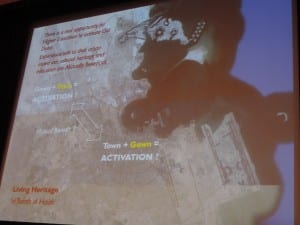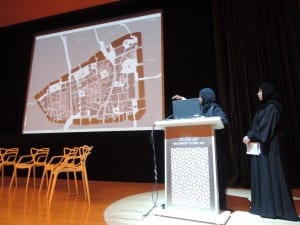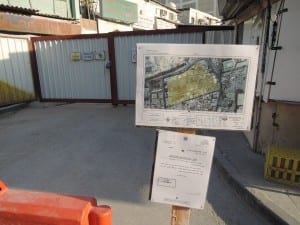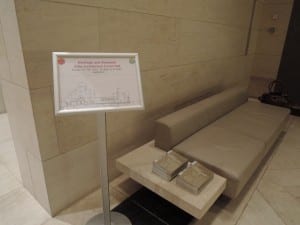‘Town to gown’ or ‘gown in town’: campus v integrated urban models of higher education development
By ucqbcme, on 18 November 2014
The potential role of higher education in ‘activating’ city centres all over the world, as opposed to generating conflict between ‘town and gown’, was highlighted at the launch on Sunday of UCL Urban Laboratory’s Urban Pamphleteer #4, dedicated to issues around the rapid redevelopment of the historic centre of Doha, Qatar. The event, held at Doha’s most recognizable landmark, the Museum of Islamic Art, concluded with a presentation from Tim Makower, a British architect based in London and Doha, who stated ‘there is a real opportunity for higher education to activate old Doha. Experience tells us that urban mixed use, cultural heritage, and education are mutually beneficial’.
Makower, who played a central role in the masterplanning and design of Doha’s fast emerging Msheireb Downtown development, was also the driving force behind the Old Doha Prize (2013) organised in Doha in collaboration with the British Council, UCL’s Bartlett School of Architecture, the RIBA, and Qatar Museums Authority. The competition, which paired selected Qatari and British collaborators, asked teams to make proposals for a sustainable, heritage-led regeneration strategy for the Al Asmakh neighourhood on the boundary of the Msheireb development. The fate of this neighbourhood, comprising narrow streets of dilapidated old mudbrick courtyard houses, small local shops, and some newer structures, inhabited by a long-standing, recently evicted, community of Doha’s migrant workers from Nepal, India and Sri Lanka, had been under question for some time.
The winning team, youandme architecture from the UK, with Fatima Fawzy and Alaa Larri from Qatar, came up with a strategy for sensitive redevelopment which puts education at its heart. The hope is that Qatar’s planning authority and government officials will be influenced to produce plans for the Al Asmakh area, now an exclusion zone marked off by barriers, which take some of these ideas on board.
Urban planning in Doha has been dominated by a zoning-based approach for many decades, resulting in a highly segregated city where residential areas, shopping and leisure zones, and commerce occupy clearly bounded territorial areas. Doha’s higher education facilities are concentrated in two principal zones, that of Qatar University near West Bay business area, and the newer, ever-expanding, Education City campus – a 20-40 minute drive from the centre depending on the traffic, with no public transport links. Education City includes a number of ‘branch campuses’ of mainly US universities, plus UCL Qatar, a postgraduate centre for studies in heritage, museums, and archaeology, as well as Qatar Faculty of Islamic Studies, and the Qatar Foundation. It is co-located with Qatar Science and Technology Park, where it is hoped that university-generated research will undergo commercial application. It is also the home of Qatar Academy, an all-through school geared towards university entrance, the Qatar National Library, a stadium, and extensive residential student accommodation.
The Education City campus is notable for its pleasant, peaceful gardens and open spaces, a collection of remarkable buildings designed by top-ranking architects such as Legorreta, Koolhaas, and Isozaki, and a wide-ranging programme of educational and cultural events. Qatar University is also architecturally noteworthy, designed by El Kafrawi, recipient of an Aga Kahn award – and currently expanding on its own campus. But both sites lie at a distance from the city centre, drawing both people and teaching and research-related activity out of it.
Both Makower and the Old Doha prize winners, speaking at the Urban Pamphleteer launch, agreed that the current regeneration of the city centre could benefit greatly from a re-integration of ‘town and gown’, animating the central areas with a range of education-related activities at the core of a new mixed-use approach to development, leavening the historic emphasis on city-centre business and retail: ‘Student life and education have a proven track record to regenerating areas. They can also enable a step-by-step regeneration that adapts to its socio-economic context. In Doha, zoned areas such as Education City and Katara Cultural Village, positioned on the edge of the city, take away a lot of life and activity from the centre. Why not have these activities happening right at the heart of Old Doha?’ (Alicja Borkowska, youandme architecture).
For further information: Urban Pamphleteer #4: Heritage and Renewal in Doha, guest-edited by Clare Melhuish, series editors Ben Campkin and Rebecca Ross, available in print and as a digital pdf.
It will launch in London on Nov 27th at UCL. For further details: http://www.ucl.ac.uk/urbanlab/events/urban-pamphleteer-4-london-launch
 Close
Close






